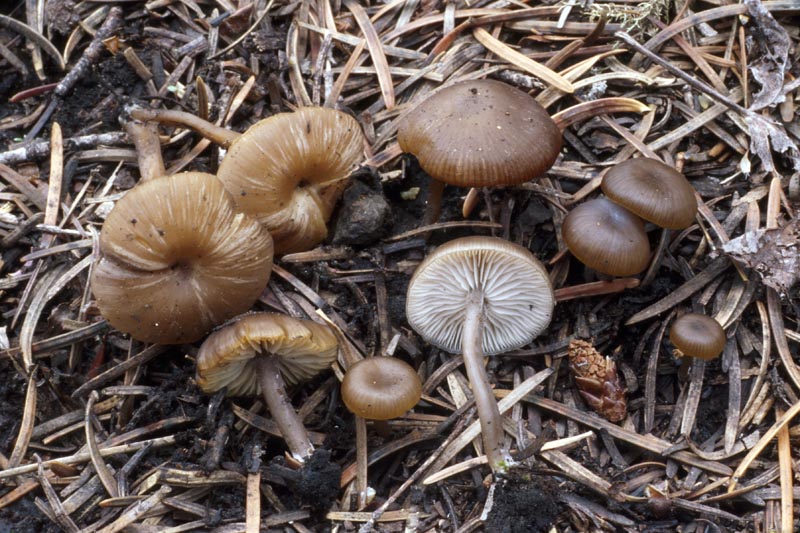
© Steve Trudell
Danny’s DNA Discoveries – Fayodiaceae of the PNW (Tricholomatineae)
by Danny Miller
|
|
Danny’s DNA Discoveries – Fayodiaceae of the PNW (Tricholomatineae)
|
|
Introduction
Fayodia - a mycenoid with round, warty, amyloid spores, making it unique under the microscope but very difficult to separate from Mycena without one. Gamundia - somewhat mycenoid, recognized microscopically by inamyloid spores that appear spiny under oil immersion from pores in the cell wall. Myxomphalia - a burn site omphalinoid with a slightly depressed cap, usually slightly decurrent gills and a somewhat viscid, gelatinous cap cuticle. Spring and fall. Amyloid spores. abundant common uncommon rare - colour codes match my Pictorial Key and are my opinions and probably reflect my bias of living in W WA. Rare species may be locally common in certain places at certain times. |
|
Fayodia Fayodia bisphaerigera EU - a mycenoid with round, warty, amyloid spores, making it unique under the microscope but very difficult to separate from Mycena without one. One OR collection has a sequence that matches a couple of EU sequences that probably represent this species. Fayodia gracilipes EU - one OR soil sample sequence matches a couple of sequences with this name, but no fruiting body has been found yet. It should be looked for. Mycena rainierensis WA - differentiated from F. bisphaerigera by being slightly paler with elongated cheilocystidia, we need a type sequence to see if it is indeed unique. If so, it needs to be moved to Fayodia. Fayodia bisphaerigera © Connor Dooley (2 images) and Yi-Min Wang (2 images) |
|
Gamundia Gamundia striatula EU - somewhat mycenoid, hygrophanous, recognized microscopically by inamyloid spores that appear spiny under oil immersion from pores in the cell wall. One ID sequence matches most EU sequences, but not all. For now I'm assuming this is the real thing. Gamundia PNW01 - A possible Gamundia leucophylla EU sequence from the EU is only 3 bp and 1 indel different than several EU Gamundia striatula EU sequences, and all the differences are in ITS1. Some synonymize them. PNW01 varies by 5 bp from those EU G. striatula sequences, but only in ITS2. Therefore, our sequences vary from the EU G. leucophylla sequence in both ITS1 and ITS2. Is it all one species or three species? We may need a multi-gene study. If it's all one species, G. leucophylla may be the oldest name. If not, our local species Mycena cineraria WA, currently thought to be synonym of Gamundia striatula, might be moved to Gamundia to become the name of this species, if that's what it is. Spores reported as 5.5-7 x 4-4.5u. Gamundia PNW02 - a unique sequence not seen before. Spores are 6.5-7.5 x 4.5-6u. It somewhat resembles the Gamundia pseudoclusilis EU, but we don't have any sequences of that. Gamunda striatula © Ed Barge (2 images), Gamundia PNW01 © Lauren Ré, Gamundia PNW02 © Yi-Min Wang |
|
Myxomphalia Myxomphalia maura EU - a burn site omphalinoid with a slightly depressed cap, usually slightly decurrent gills and a somewhat viscid, gelatinous cap cuticle. It may smell spermatic like Inocybe. Spring and fall. Amyloid spores. There is a burn site Lyophyllum, but it is not viscid and does not have an indented cap. An OR sequence, AK sequence and other east and west coast sequences match EU sequences very well. unsequenced Myxomphalia maura © Steve Trudell |